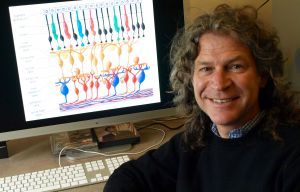
Publisher:
Bonnie King
CONTACT:
Newsroom@Salem-news.com
Advertising:
Adsales@Salem-news.com

~Truth~
~Justice~
~Peace~
TJP
May-05-2011 22:27

 TweetFollow @OregonNews
TweetFollow @OregonNews
Forecast Calls for Nanoflowers to Help Return Eyesight
Salem-News.com"We're right at the start of this amazing voyage" - University of Oregon physicist Richard Taylor
 University of Oregon physicist Richard Taylor |
(EUGENE, Ore.) - University of Oregon physicist Richard Taylor is working to turn a patent based on a vision into fractal technology that, when implanted behind the eyes, will deliver renewed eyesight with high resolution.
University of Oregon researcher Richard Taylor is on a quest to grow flowers that will help people who've lost their sight, such as those suffering from macular degeneration, to see again.
These flowers are not roses, tulips or columbines. They will be nanoflowers seeded from nano-sized particles of metals that grow, or self assemble, in a natural process -- diffusion limited aggregation. They will be fractals that mimic and communicate efficiently with neurons.
Fractals are "a trademark building block of nature," Taylor says. Fractals are objects with irregular curves or shapes, of which any one component seen under magnification is also the same shape. In math, that property is self-similarity. Trees, clouds, rivers, galaxies, lungs and neurons are fractals, Taylor says. Today's commercial electronic chips are not fractals, he adds.
Eye surgeons would implant these fractal devices within the eyes of blind patients, providing interface circuitry that would collect light captured by the retina and guide it with almost 100 percent efficiency to neurons for relay to the optic nerve to process vision.
In an article titled "Vision of beauty" for Physics World, Taylor, a physicist and director of the UO Materials Science Institute, describes his envisioned approach and how it might overcome the problems occurring with current efforts to insert photodiodes behind the eyes. Current chip technology is limited, because it doesn't allow sufficient connections with neurons.
"The wiring -- the neurons -- in the retina is fractal, but the chips are not fractal," Taylor says. "They are just little squares of electrodes that provide too little overlap with the neurons."
Beginning this summer, Taylor's doctoral student Rick Montgomery will begin a yearlong collaboration with Simon Brown at the University of Canterbury in New Zealand to experiment with various metals to grow the fractal flowers on implantable chips.
The idea for the project emerged as Taylor was working under a Cottrell Scholar Award he received in 2003 from the Research Corporation for Science Advancement. His vision is now beginning to blossom under grants from the Office of Naval Research (ONR), the U.S. Air Force and the National Science Foundation.
Taylor's theoretical concept for fractal-based photodiodes also is the focus of a U.S. patent application filed by the UO's Office of Technology Transfer under Taylor's and Brown's names, the UO and University of Canterbury.
The project, he writes in the Physics World article, is based on "the striking similarities between the eye and the digital camera."
"The front end of both systems," he writes, "consists of an adjustable aperture within a compound lens, and advances bring these similarities closer each year." Digital cameras, he adds, are approaching the capacity to capture the 127 megapixels of the human eye, but current chip-based implants, because of their interface, are only providing about 50 pixels of resolution.
Among the challenges, Taylor says, is determining which metals can best go into body without toxicity problems. "We're right at the start of this amazing voyage," Taylor says. "The ultimate thrill for me will be to go to a blind person and say, we're developing a chip that one day will help you see again. For me, that is very different from my previous research, where I've been looking at electronics to go into computers, to actually help somebody … if I can pull that off that will be a tremendous thrill for me."
Taylor also is working under a Research Corp. grant to pursue fractal-based solar cells.
Source:
Richard Taylor, professor of physics, director of Materials Science Institute, 541-346-4741, rpt@uoregon.edu
Links:
Physics World article: physicsworld.com/cws/article/indepth/45840
Taylor faculty page: physics.uoregon.edu/faculty/taylor.html
Physics department: physics.uoregon.edu/index.html
Materials Science Institute: http://materialscience.
UO Office of Technology Transfer: http://techtran.uoregon.edu/
Simon Brown faculty page: http://www.phys.canterbury.ac.
Audio Clip with Taylor: http://comm.uoregon.edu/files/
Follow UO Science on Facebook: www.facebook.com/UniversityOfOregonScience
Source: University of Oregon
Articles for May 4, 2011 | Articles for May 5, 2011 | Articles for May 6, 2011

Quick Links
DINING
Willamette UniversityGoudy Commons Cafe
Dine on the Queen
Willamette Queen Sternwheeler
MUST SEE SALEM
Oregon Capitol ToursCapitol History Gateway
Willamette River Ride
Willamette Queen Sternwheeler
Historic Home Tours:
Deepwood Museum
The Bush House
Gaiety Hollow Garden
AUCTIONS - APPRAISALS
Auction Masters & AppraisalsCONSTRUCTION SERVICES
Roofing and ContractingSheridan, Ore.
ONLINE SHOPPING
Special Occasion DressesAdvertise with Salem-News
Contact:AdSales@Salem-News.com

Salem-News.com:
googlec507860f6901db00.html

Terms of Service | Privacy Policy
All comments and messages are approved by people and self promotional links or unacceptable comments are denied.
[Return to Top]
©2025 Salem-News.com. All opinions expressed in this article are those of the author and do not necessarily reflect those of Salem-News.com.